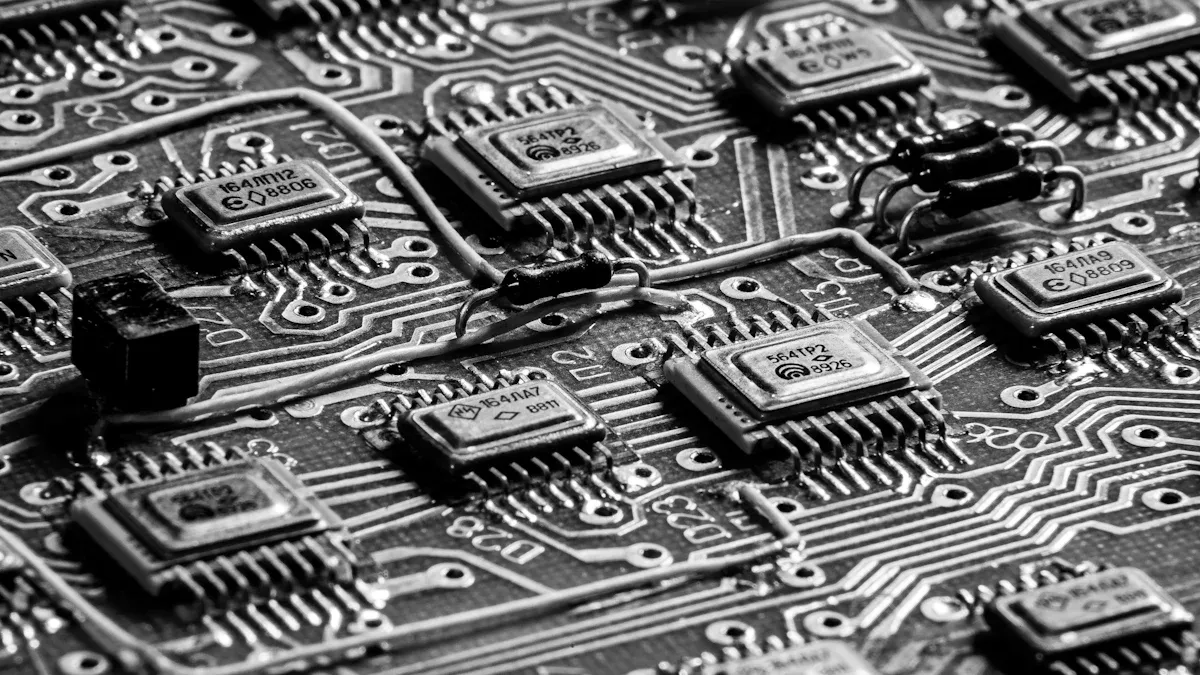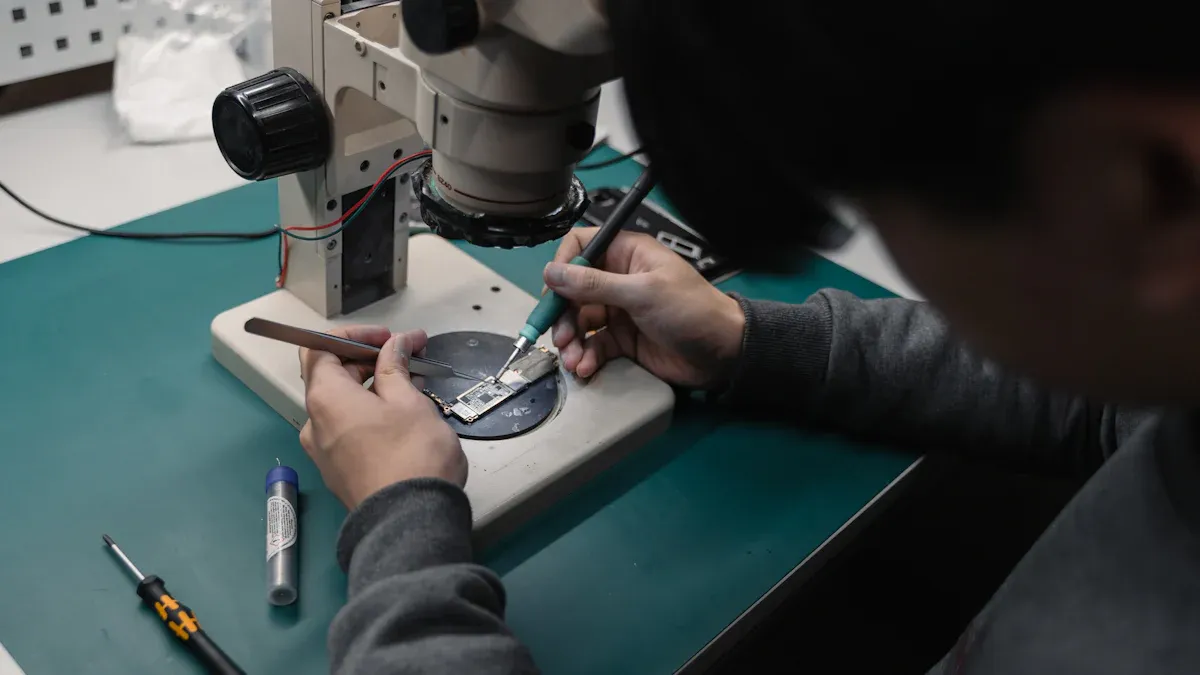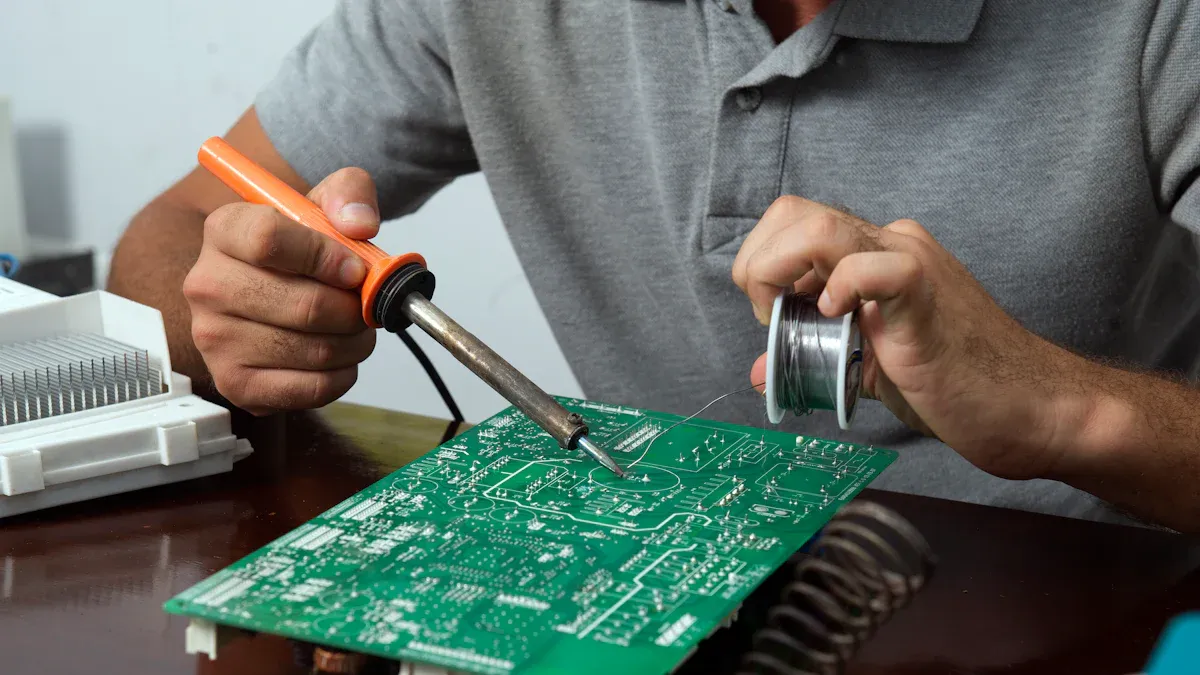The differences between spray solder mask and screen solder mask for PCB boards

A solder mask is a layer that protects a PCB. It keeps copper parts safe from rust and short circuits. Spray solder mask is sprayed evenly on the board. Screen solder mask uses a stencil to put it on. Picking the right method helps your PCB work well and last longer.
Key Takeaways
Spray solder mask spreads evenly and works well for tricky designs. It protects better from rust and harm.
Screen solder mask is cheaper and accurate for easy designs. It fits big projects and common gadgets.
Pick the right solder mask based on your PCB's design, thickness, and rules for best results.
Understanding Solder Mask and Silkscreen
What is a solder mask?
A solder mask is a thin layer that protects PCBs. It covers copper lines to stop rust and damage. This coating also stops solder from connecting wrong points by accident. Adding this layer makes your PCB last longer and work better.
Purpose of solder mask in PCB manufacturing
The solder mask is very important when making PCBs. It helps stop short circuits and improves how the board works. It also makes sure solder sticks only where it should. Without it, copper parts could get damaged and not last as long.
Role of silkscreen in PCB design
The silkscreen goes on top of the solder mask. It shows symbols, letters, and numbers to guide users. These markings help you find parts and understand connections. For example, it shows what each pin or LED does. Together, the solder mask and silkscreen make PCBs easier to use and more reliable.
Spray solder mask: Application and benefits

How spray solder mask is applied
Spray solder mask is put on using special spray tools. First, the PCB is cleaned to remove dirt or grease. Next, the liquid solder mask is sprayed evenly over the board. This covers all copper lines and small holes completely. After spraying, the board is dried to harden the coating. This method creates a smooth layer, even on tricky designs.
Advantages of spray solder mask
Spray solder mask has many good points. It covers PCBs well, even with detailed or uneven designs. This method lowers problems like filling errors by almost 98%. Factories see a 15% boost in making good boards. New spray tools make the job faster, cutting time by 30%. This saves money and makes the solder mask stronger. It also protects better from water and rust, keeping PCBs reliable.
Common use cases for spray solder mask
Spray solder mask works great for HDI and multilayer PCBs. These boards have tight layouts needing careful solder mask placement. It’s often used in areas needing strong boards, like phones or electronics. If your PCB has tiny parts or detailed patterns, this method helps it last longer and work better.
Screen solder mask: Application and benefits

How screen solder mask is applied
Screen solder mask is added using a stencil or screen. First, the PCB is cleaned to remove dirt or grease. Next, a stencil is placed on the board, matching the design. Liquid solder mask is spread over the stencil to fill areas. After that, UV light or heat hardens the solder mask. This method places the solder mask exactly where it’s needed. It works well even for boards with tricky designs.
Advantages of screen solder mask
Screen solder mask has many benefits for PCBs.
It adds a strong layer that protects copper from rust.
The process is precise, stopping damage and making boards last longer.
Factories use it to turn plain boards into professional ones quickly.
This method gives a tough, high-quality finish for modern electronics.
Common use cases for screen solder mask
Screen solder mask is great for boards needing exact impedance control. Without it, impedance can be wrong, hurting performance. It’s often used in telecom and industrial devices needing high standards. For big projects or consistent results, this method ensures reliable PCBs.
Comparing spray solder mask and screen solder mask
How they are applied and their accuracy
Spray and screen solder masks are applied in different ways. Spray solder mask uses a tool to evenly coat the PCB. It works well for tricky designs and odd shapes. This method is great for boards with tiny parts and tight layouts. Screen solder mask uses a stencil to place the coating. It’s good for simple designs but less accurate for detailed patterns.
Here’s a quick look at how they compare:
Application Method | Pros | Cons |
|---|---|---|
Screen Printing | Cheap for small or medium projects | Not precise for tiny parts |
Spray Coating | Accurate for odd shapes and detailed designs | Needs careful setup of tools and materials |
Electrostatic Spray | Very precise for tight layouts | Costs more and needs special equipment |
Spray methods, especially electrostatic spray, are very accurate. But they need advanced tools and skilled workers.
Material use and cost
Spray solder mask uses more material because of overspray. This can make it more expensive. But it’s worth it for detailed designs that need high performance. Screen solder mask uses less material since the stencil applies it exactly. This makes it cheaper for simple designs or big projects.
If your design is basic and you want to save money, screen solder mask is a good choice. For complex designs, spray solder mask’s extra cost is worth the precision.
Best fit for different PCB designs
The type of PCB design affects which solder mask is better. Spray solder mask is great for HDI and multilayer PCBs. These designs have tight spaces and small parts needing careful coating. Screen solder mask works well for single-layer or simple PCBs. It’s affordable and easy to use for everyday electronics and industrial devices.
For detailed designs with tiny parts, spray solder mask is best. For simpler boards, screen solder mask is a reliable and cheaper option.
Environmental impact
Spray solder mask can create more waste due to overspray. This waste needs proper disposal to avoid harm. New spray systems, like electrostatic spray, help reduce waste but still need careful handling. Screen solder mask uses materials efficiently and creates less waste. It’s usually better for the environment.
If you care about being eco-friendly, screen solder mask is a good choice. However, spray technology is improving to be more sustainable over time.
LT CIRCUIT’s expertise in solder mask and silkscreen applications
LT CIRCUIT’s approach to spray solder mask
LT CIRCUIT uses advanced tools for spray solder masks. These tools spread the solder mask evenly on all PCBs. First, the board is cleaned to remove dirt or grease. Then, the solder mask is sprayed smoothly, creating a strong layer. This method works well for complex designs like HDI and multilayer boards. LT CIRCUIT uses modern equipment to reduce waste and improve accuracy. This ensures your PCBs are reliable and perform at their best.
LT CIRCUIT’s approach to screen solder mask
LT CIRCUIT carefully applies screen solder masks using stencils. They make sure the solder mask fits perfectly to avoid mistakes. The process starts by setting up the PCB layout to prevent solder bridges. They adjust the solder mask thickness to match copper traces, keeping it at least 0.8 mils thick. This method follows strict industry rules, making it great for aerospace and medical devices. The result is a smooth finish that helps soldering and makes PCBs last longer.
Why choose LT CIRCUIT for your PCB needs?
LT CIRCUIT is a trusted choice for solder mask and silkscreen work. They focus on quality, accuracy, and new technology. Their team can handle both spray and screen solder mask methods. Whether you need detailed HDI boards or simple PCBs, they deliver great results. They also follow industry rules and care about the environment. With LT CIRCUIT, your PCBs will work well in any device.
Choosing the right solder mask for your PCB
Things to think about when picking a solder mask method
Picking the best solder mask method depends on key points. These points help your PCB work well and last longer. Here’s a simple table of what to consider:
Factor | What It Means |
|---|---|
Important for protecting the PCB without causing soldering issues. | |
Solder Mask Color | Affects clarity; green is clearest, but other colors have special uses. |
Industry Standards | Following rules like IPC-SM-840 ensures strong, long-lasting, and chemical-safe PCBs. |
When choosing a solder mask, focus on thickness to protect the board while keeping soldering easy. The color you pick also matters. Green gives the clearest details, but black or white might fit certain designs better. Always check that the solder mask meets industry rules to make sure it’s tough and safe from chemicals.
Deciding between spray and screen solder masks depends on your PCB’s design and needs. Spray solder masks are very precise, while screen solder masks are faster and cheaper.
Feature | Spray Solder Mask | Screen Solder Mask |
|---|---|---|
How It’s Applied | Liquid sprayed evenly | Liquid spread using a stencil |
Covers the whole board except pads/holes | Only covers SMD pads | |
Automation | Can be manual or automated | Mostly automated with stencils |
Speed | Slower because it’s often manual | Faster for large projects |
Material Used | Liquid solder mask | Solder paste with tin and flux |
Picking the right method helps your PCB work well and last longer. LT CIRCUIT offers expert solutions for both methods. Their advanced tools and focus on quality make them a top choice for PCB production.
FAQ
What’s the key difference between spray and screen solder masks?
Spray solder masks are sprayed on evenly like paint. Screen solder masks use stencils to apply the coating exactly. Spray works best for detailed designs. Screen is great for simple layouts.
Which solder mask is best for HDI PCBs?
Spray solder masks are perfect for HDI PCBs. They cover tight spaces and tiny parts well. This makes the boards strong and reliable.
Can LT CIRCUIT do both solder mask methods?
Yes, LT CIRCUIT can handle both methods. They use advanced tools to make sure all PCB designs turn out great.
See Also
How Tin Immersion Affects Solder Mask Stability in PCBs
The Benefits of Solder Mask LDI for Reducing Bridge Size
Addressing Common PCB Design Issues for SMT Technology Needs
Effects of Vertical Continuous Electroplating on Copper Thickness Uniformity
Importance of Vacuum Two-Fluid Etching for Precision PCB Manufacturing
